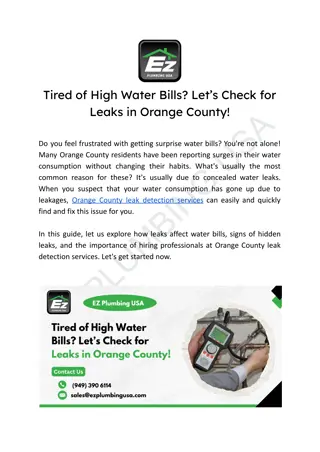Insurance & Bonding Requirements for Orange County Contractors
Presented by Susan Martin, ARM-P, CWCP, Risk Management Administrator for Orange County, this informative guide outlines the necessary insurance and bonding requirements for contractors conducting business with the county. Covering basic coverage necessities such as Commercial General Liability, Business Auto Liability, Workers Compensation, and Employers Liability, as well as additional coverage based on the scope of services, the presentation serves as a comprehensive resource for ensuring compliance with Orange County regulations.
Download Presentation

Please find below an Image/Link to download the presentation.
The content on the website is provided AS IS for your information and personal use only. It may not be sold, licensed, or shared on other websites without obtaining consent from the author.If you encounter any issues during the download, it is possible that the publisher has removed the file from their server.
You are allowed to download the files provided on this website for personal or commercial use, subject to the condition that they are used lawfully. All files are the property of their respective owners.
The content on the website is provided AS IS for your information and personal use only. It may not be sold, licensed, or shared on other websites without obtaining consent from the author.
E N D
Presentation Transcript
Surety Bond Evolution Where were we? Early 2000 s - surety bonds were acceptable form of financial assurance in some markets. Why? Less complexity Fewer market participants Smaller collateral obligations Where are we now? Two ISO s, ERCOT and NYISO, allow for the use of surety bonds as financial assurance to cover credit exposure Surety bond language over the years has become more aligned with letters of credit Surety companies are willing to underwrite structured bond language Where are we going? With the shift in the ISO and surety landscape, surety bonds have emerged as an additional option for financial assurance As market participants/ISO s, and surety companies become more informed on surety bonds and energy obligations respectively, there will be a growing desire to utilize this instrument moving forward Today is to provide background on Surety Bonds and discuss the potential benefits they could afford market participants as well as ERCOT
Surety Bond Basics What is a Surety Bond? A written agreement where a surety guarantees the principal will live up to or perform a specific obligation with the obligee Surety bond language must be agreed upon by all three-parties, but can be structured in various ways Surety bonds are issued by surety companies, who are generally subsidiaries of insurance companies. A surety company must receive the approval from the U.S. Department of Treasury to issue bonds domestically How is a Surety Bond underwritten? Each surety bond is evaluated by the surety on an individual basis Surety s consider the principal s financial profile, the bond terms (type, tenor), the principal s bond portfolio risk profile, and the bond underlying obligations. This process allows the principal and surety to develop a better understanding with each other and surety to provide more competitive pricing than LCs Relevant Surety Bond Types 1 Contract Bonds are exclusively secured by firms guaranteeing a contract which guarantees that contract will be fulfilled Payment Bond is an agreement between the obligee, the principal, and the surety bond company underwriting the bond Performance Bonds guarantee that a contract will be completed per the specifications of the contract. It protects the oblige in case of principal defaults Surety bonds are a secure form of financial assurance, which are underwritten and priced based upon criteria of the Principal s financial health and underlying obligation 1Other surety bond types exist, however, we have limited our focus to the relevant ones for ISO collateral3
Surety Bond/LC Similarities and Differences Surety Bonds VS Letters of Credit (LC) Definitions Surety - A legally binding contract that ensures obligations will be met between the principal, obligee, and the insurance company LoC - A letter from a bank guaranteeing that a buyer s payment to a seller will be received on time and for the correct amount Borrowing Capacity Surety Surety - Bonds are usually issued on an unsecured basis, and do not diminish a company s borrowing capacity LoC - The issuance of LCs diminish the borrowing capacity on the line of credit that a company has been extended Duration Surety - Surety bonds typically remain in force for the duration of the underlying contract they support and/or are determined by the terms and conditions of the bond LoC - An LC expiration date is specified within the LC language and is generally one year LCs may also contain evergreen or auto-renew clause which allow the LC to automatically renew for a specified time Claims Surety - The obligee must declare the principal in default by filing a claim with the surety The surety has the option to investigate the claim to ensure the terms and conditions of the bond were met, but must ensure to make the obligee whole within the timeframe set within the bond LoC - The beneficiary must submit a draw certificate, per the LC language, to the bank. Depending on the size of the draw, the bank will then work to have the funds transferred to the beneficiary as soon as possible
View of the Pros and Cons Pros - Cost Savings, Collateral Optionality, Liquidity Increasing, Collateral Diversification Since the 2008 financial crisis and agreement of Basel III, the cost of LCs have increased while surety premiums have remained stagnant 1 The more robust underwriting process an insurance company goes through allows them to more competitively price bonds Increasing collateral optionality enhances market participants ability to strategically manage their collateral portfolios to align with their needs The use of surety bonds frees up liquidity capacity and can be viewed as a credit enhancement Accepting surety bonds will mitigate ERCOT s concentration exposure to big banks by diversifying their collateral portfolio with Sureties Cons - Non-Payment Risk, Limited Market Risk: non-payment or delay in payment Mitigant Mitigant: Structure bond language similar to LC s Risk: Limited market of insurance companies willing to underwrite ISO bonds Mitigan Mitigant: Educating the sureties on low risk nature of the obligations The pros of using surety bonds as collateral to cover ISO obligations clearly outweigh the cons 5
Value to ERCOT and its participants Accepting bonds will open large pools of liquidity support, free up the balance sheet of participants, provide a better credit profile to the ISO and do all of this at less risk and a lower cost than typical LC facilities.
Immediate Concerns Limits per entity and surety Today, this is not consistent with what is accepted from the banks. Surety in general is superior credit to most US banks Payout trigger and timing The current bond from triggers on bankruptcy, even if the participant is in good standing at ERCOT bankruptcy does not necessarily equal default More reasonable payout periods inclusive of cure periods would bring access to 10 figure liquidity gains for ERCOT and its participants at LESS risk.























